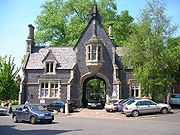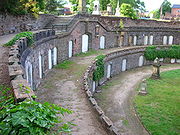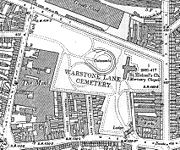
Warstone Lane Cemetery
Encyclopedia



Cemetery
A cemetery is a place in which dead bodies and cremated remains are buried. The term "cemetery" implies that the land is specifically designated as a burying ground. Cemeteries in the Western world are where the final ceremonies of death are observed...
dating from 1847 in Birmingham
Birmingham
Birmingham is a city and metropolitan borough in the West Midlands of England. It is the most populous British city outside the capital London, with a population of 1,036,900 , and lies at the heart of the West Midlands conurbation, the second most populous urban area in the United Kingdom with a...
, England
England
England is a country that is part of the United Kingdom. It shares land borders with Scotland to the north and Wales to the west; the Irish Sea is to the north west, the Celtic Sea to the south west, with the North Sea to the east and the English Channel to the south separating it from continental...
. It is one of two cemeteries located in the city's Jewellery Quarter
Jewellery Quarter
The Jewellery Quarter is an area of Birmingham City Centre, England, situated in the south of the Hockley area. It is covered by the Ladywood district. There is a population of around 3,000 people in a area....
, in Hockley
Hockley, Birmingham
Hockley is a central inner-city district in the city of Birmingham, England. It lies about one mile north-west of the city centre, and is served by the Jewellery Quarter station...
(the other being Key Hill Cemetery
Key Hill Cemetery
Key Hill Cemetery, , originally called Birmingham General Cemetery, a Nonconformist cemetery, is the oldest cemetery in Birmingham, England. It opened on 23 May 1836. Located in Hockley, the city's Jewellery Quarter, it is one of two cemeteries there...
). It is no longer available for new burials.
A major feature is the two tiers of catacombs
Catacombs
Catacombs, human-made subterranean passageways for religious practice. Any chamber used as a burial place can be described as a catacomb, although the word is most commonly associated with the Roman empire...
, whose unhealthy vapours led to the Birmingham Cemeteries Act which required that non-interred coffins should be sealed with lead or pitch.
The foundation stone for the chapel (demolished 1954) was laid on 6 April 1847. The blue brick lodge gate (Hamilton & Medland 1848) building survives and is grade II listed. The cemetery is itself grade II on the Register of Parks and Gardens of Special Historic Interest
National Register of Historic Parks and Gardens
In England, the Register of Historic Parks and Gardens of special historic interest in England provides a listing and classification system for historic parks and gardens similar to that used for listed buildings. The register is managed by English Heritage under the provisions of the National...
.
On the night of 11th December 1940, all but the fine tower and classical west portico of St Thomas' Church, Bath Row, was destroyed by German bombs. The church was never rebuilt. The grounds were laid out for the coronation of Queen Elizabeth II in 1953 when the gravestones were removed and the dead reinterred at Warstone Lane Cemetery. The gardens were re-designed as the St. Thomas's Peace Garden in 1995 in commermoration of the fiftieth anniversary of the end of World War II
World War II
World War II, or the Second World War , was a global conflict lasting from 1939 to 1945, involving most of the world's nations—including all of the great powers—eventually forming two opposing military alliances: the Allies and the Axis...
A comprehensive list of memorial inscriptions is being prepared by The Jewellery Quarter Research Group (September 2011). This will shortly be available on their web-site JQRG.ORG.
A campaign group is working to preserve and protect the cemetery - The Friends of Key Hill & Warstone Lane Cemeteries.
Notable people buried there include:
- John BaskervilleJohn BaskervilleJohn Baskerville was an English businessman, in areas including japanning and papier-mâché, but he is best remembered as a printer and typographer.-Life:...
- James Cooper VCJames Cooper (VC)James Cooper VC was an English recipient of the Victoria Cross, the highest and most prestigious award for gallantry in the face of the enemy that can be awarded to British and Commonwealth forces.-Details:...
- Dr Pye Chavasse - medical author
- John Postgate - Food Safety campaigner
- Clement Ingleby - Solicitor & Poet
- Joseph Allday - Radical Politician
- Harry Gem - Lawn Tennis pioneer
Sources
- The Jewellery Quarter - History and Guide, Marie Elizabeth Haddleton, ISBN 0-9513108-0-1

